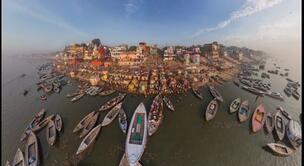Famous Temples of Northern India

Amritsar
Established in 1577 by the fourth Sikh guru, Guru Ram Das, Amritsar is home to the spectacular Golden Temple, Sikhism's holiest shrine and one of India’s most serene and humbling sights. The hyperactive streets surrounding the temple have been calmed to some extent by recent urban landscaping, including graceful pedestrianised walkways, but duck into any side alley and you’ll soon discover Amritsar’s fantastically frenetic old-city bazaars, sheltering a sensory overload of sights, sounds and smells.
Varanasi
Varanasi is the India of your imagination. This is one of the world's oldest continually inhabited cities, and one of the holiest in Hinduism. Pilgrims come to the Ganges here to wash away sins in the sacred waters, to cremate their loved ones, or simply to die here, hoping for liberation from the cycle of rebirth.
Khajurahoo
India's most titillating town is famed far and wide for the erotic stone carvings that swathe Khajuraho’s three groups of World Heritage–listed temples. The Western Group of temples, in particular, contains some stunning sculptures that together make up some of the finest temple art in the world.
Tour cost starts from Rs.75000 per person
Itinerary
- Day 1
Arrival Amritsar
Upon arrival at Amritsar Airport in the morning, meet & greet by our rep. and transfer to hotel for check in
Amritsar is a city in the north-western part of India. It is the spiritual centre for the Sikh religion and the administrative headquarters of the Amritsar district in the state of Punjab
Today we embark on a sightseeing tour of Amritsar covering The Golden Temple, Jalianwala baug, Wagha Border for change of guards ceremony, etc
Golden Temple
The holiest abode of the Sikhs all over the world, the Golden Temple at Amristar is popularly called as the Sri Harmandir Sahib. The idea behind this sacred shrine was conceived by Guru Arjan Sahib, who himself designed the structure of the temple. The gurudwara is considered as an architectural wonder which showcases a magnificent blend of Hindu and Muslim styles of architecture.
Jallianwala Bagh
A historical monument that tells the sad story of mass killing during the independence movement in India. Jallianwala Bagh is now a public garden site of Massacre which houses a memorial, established in 1951, to pay homage to the thousands of people, who were killed in the incident. Around 10,000 people gathered at the Jallianwala Bagh to peacefully protest against the Rowlatt Act, on 13th April 1919. Brigadier-General Reginald Dyer with his army of 150 troops ordered open fire at the crowd. 400 people were killed on the spot and 1500 wounded people were left to die in the well within the garden.
Wagah Border
Attari Wagah Border is the only road border crossing between India and Pakistan. Often known as Berlin wall of Asia, this border lies on the Grand Trunk Road between Amritsar and Lahore. On this border, a retreat ceremony called 'lowering of the flags’ is held every evening, since 1959. During the ceremony, Border Security Force (B.S.F) of India and the Pakistan Rangers soldiers perform energetic parade. This 40 to 45 minutes ceremony takes place every evening before sunset at the Wagah Border. As the sun sets, the iron gate at the border is opened and the flags of India and Pakistan are lowered and folded by their respective soldiers. The ceremony ends with a handshake between the soldiers of both the countries. Wagah Border opens between 10 am and 4 pm, while the flag down ceremony starts at 4:30pm and ends with the national anthem at 5 pm. It is located around 28 kms from Amritsar – Atleast 1 hour drive.
Foreign Nationals should carry their passports during visit to Wagha Border to get preferential seats
Evening service at Golden Temple
Overnight at Amritsar - Day 2
Amritsar to Varanasi
Morning service at Golden Temple
Later transfer to Amritsar airport for flight to Varanasi via Delhi
Upon arrival at Varanasi airport, transfer to Hotel for check in
Varanasi is the holiest city of the Hindu world, filled with temples and teeming with cultural life. In Varanasi the Ganges river is considered a living goddess who is revered as Ganga Ma. Without the river Varanasi would not exist as we know it. Considered as the abode of Lord Shiva, River Ganges is believed to have the power of washing away all of one's sins. As pundits here will tell you, whatever is sacrificed and chanted here or given in charity reaps its fruits thousand times more than those good deeds performed at other places because of the power of that place
Later a short sightseeing tour of Varanasi & Aarti on the ghats of Ganges
Varanasi being a centre for Hindu customs, temples form the main attraction. The Ganga Ghats (river fronts) are the main center of religious activities and rituals and also form one of the main attractions of Varanasi. The Alamgir Mosque, blend of the Hindu and Mughal styles of the architecture, is another important attraction of Varanasi. Some of the most important temples of Varanasi are Durga temple, Vishwanath temple, Sankat Mochan temple, Tulsi Manas temple and the Bharat Mata temple.
Evening Aarti
Ganga Aarti at Dasaswamedhghat, close to KashiVishwanath Temple, is one of the prime attractions of Varanasi. It starts just after sunset, with a bunch of young men choreographing to the chantings, holding the lamps. People start arriving at the ghats as early as 5pm. Dasaswamedhghat becomes a hub of activity, with people sitting and waiting for the aarti, buying flowers and other things from nearby shops or performing pooja. It is conducted every sunset by five white-robed priests - These five young men sway in seemingly choreographed movements, worshiping the river goddess with incense, camphor, flowers and earthen lamps. Thousands of illuminated lamps are immersed in the waters of the holy Ganges and the floating lamps add a divine look to the river at dusk. Sit with some ‘sadhu’ and enjoy knowing their lifestyle from close proximity. You might even run into someone who is more than 100 years old! The Ghats also provide a good option for photography with serene temples and their bustling courtyards creating a perfect backdrop.
Overnight at Varanasi - Day 3
Varanasi / Excursion to Allahabad & Sarnath
Early morning boat ride on the Ganges
We rise before dawn and step gingerly in the boat as the boatman starts rowing the boat. We wait for the daily miracle to unfold, as the Sun appears triumphantly over the horizon. The sound of conches and temple bells add to the delicate pink fabric of dawn. The formerly hushed murmuring of ancient Sanskrit ‘Shlokas’ now rises, in one voice, to a crescendo of unparalleled piety and joy.
Back to hotel for breakfast & later depart for excursion to Allahabad & Sarnath
Allahabad - Allahabad or Prayag is also called the "Tirth Raj", the king of all pilgrimage centers. There are many references to Prayag or Allahabad in Indian epics, Vedas and Puranas. Allahabad stands at the confluence of the Ganga and Yamuna (two of India's holiest rivers) and Saraswati River (a mythical river which is not visible). The place where river Ganga and river Yamuna meet is called Sangam (union). Sangam is the venue of many sacred fairs and rituals, and attracts thousands of pilgrims throughout the year.
Triveni Sangam - The Triveni Sangam in Allahabad is a confluence of three rivers, the Gange, Yamuna and Saraswati. Of these three, river Saraswati is invisible and is said to be flowing beneath the earth. It meets the other two rivers from the base. The point of confluence is a sacred place for the Hindus, as it is of high religious importance to the Hindus. A bath here is said to wash all the sins and free human from the cycle of birth. The site of Sangam is a treat to the eyes. One can see the muddy and pale yellow water of Ganges merging with green water of Yamuna. The Ganges is only 4 ft deep, while Yamuna is 40 ft deep near the point of nexus. The river Yamuna ends at this point and Ganges continues after this till it meets sea at Bay of Bengal.
En route on return visit Sarnath - The site of the deer park where Gautama Buddha is said to have given his first sermon about the basic principles of Buddhism. It has been a premier centre for Buddhism & has a rich collection of ancient Buddhist relics & antiques comprising numerous Buddha & Bodhisattva images on display at the Archaeological Museum.
Evening at leisure to visit the local market
Overnight at Varanasi - Day 4
Varanasi to Khajurahoo
Flight from Varanasi to Khajurahoo
Upon arrival at Khajurahoo airport transfer to Hotel for check in
Khajurahoo oozes with passion, eroticism, dance and music and other finesses of creative arts depicted in sculpture and images of the temples. The 85 temples were built in North Indian 'Nagara' style of architecture, though only 20 of them have survived the rough weather conditions over long years of time
Later in the evening Light & Sound Show
This fascinating light & sound spectacle evokes the life and times of the great Chandela Kings and traces the story of the unique temples from the 10th Century to the present day. The 50 minutes sound and light show is conducted by tourism department in the garden of western group of temples. The show is entertaining and informative about the construction, history and importance of the temples. The show runs in Hindi and English every evening. The life and times of the great Chandela kings and the legend and grandeur of the unique temples from the 10th century to the present day are narrated in the voice of Amitabh Bachchan – the Bollywood legend.
Overnight at Khajurahoo - Day 5
Khajurahoo - Local sightseeing
Khajurahoo local sightseeing : Full day Temple Visit : Western, Eastern & Southern group of Temples
THE TEMPLES
The architectural style of the Khajurahoo temples is very different from the temple prototype of that period. Each stands, instead of within the customary enclosure, on a high masonry platform. Combined with the upward direction of the structure, which is further accentuated by vertical projections, the total effect is one of grace and lightness, reminiscent of the Himalayan peaks. Each of the chief compartments has its own roof, grouped in such a way that the highest is in the centre, the lowest over the portico, a triumph of skill and imagination in recreating the rising peaks of a range.
The temples of Khajurahoo are divided into three geographical groups: Western, Eastern and Southern.
The Western group is certainly the best known, because it is to this group that the largest and most typical Khajurahoo temple belongs: The Kandariya Mahadev. Perfectly symmetrical, it soars 31 km high. Though the four temples that stand at the corners of the main shrine are now in ruins, the main shrine has an exquisitely carved entrance arch with a multitude of themes. Celestial beings, lovers serenading musicians... movements captured in stone, frozen in time, yet retaining a quality of warm, pulsating life. The very stone seems to have taken on the living, breathing quality of the carved figures.
Beyond the archway of the Kandariya Mahadev, lie the six interior compartments; the portico, main hall, transept, vestibule, sanctum and ambulatory. The ceilings are particularly noteworthy and the pillars supporting them have intricately carved capitals. The transept's outer walls have three horizontal panels showing deities of the Hindu pantheon, and groups of lovers, a pageant of sensuousness, vibrantly alive.
Also in the western group is the Chaunsat Yogini, the only granite temple in the Khajurahoo group. Dedicated to Kali, it is also unique in being quadrangular in plan. Only 35 of the original 65 cells remain and no image of Kali has survived: not surprisingly, since this is the earliest surviving shrine of the group dated to 900 AD.
Another Kali Temple (originally dedicated to Vishnu) is the Devi Jagadambe Temple. North of it facing eastward to the rising sun, is the Chitragupta temple, dedicated to the sun-god, Surya. The image of this powerful deity in the inner sanctum is particularly imposing: 5ft high, and driving a seven-horsed chariot. The group scenes depicted are equally spectacular: royal processions, elephant-fights, hunting scenes, group dances. The lavish lifestyle of the Chandela kings and their court is here in all its pomp and glory.
Overnight at Khajurahoo - Day 6
Departure from Khajurahoo
Morning at leisure
Later transfer from hotel to airport for departure flight
Notes
Round the Year Destination ... Extention available to other Destinations across MP
Hotels
Tour Inclusions [Amritsar - Varanasi - Khajurahoo]
1 night stay at Amritsar
2 nights stay at Varanasi
2 nights stay at Khajurahoo
Daily breakfast at hotels
Transport by a private vehicle
All sightseeings accompanied by our local guide
Boat ride at Varanasi
Light & sound show at Khajurahoo
Notes on itinerary
All our itineraries are "Just for Ideas" ... We will get to know you and customise an itinerary just for you that matches your requirements ... dates of travel, category of hotels, preferred airline, flexibility in choosing sightseeing, mode of travel between cities, etc.
Many of our clients have us design more relaxing, slower paced holidays with more in-depth experiences whereas some simply want to visit various destinations and cover only the highlights.
Together, we will determine the ideal route, pace of travel, accommodations, levels of pampering, style of touring, sightseeing to be included, dining preferences, adventure levels, options to meet locals, dates of travel & much more ! and based on this arrive at a price.
Do feel free to get in touch with us by a quick call on +91 79 29602961 or a short mail on mail@destinations4india.com ... Looking forward



















